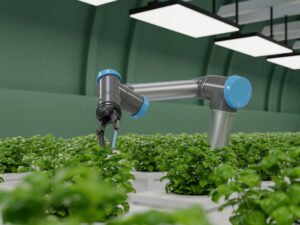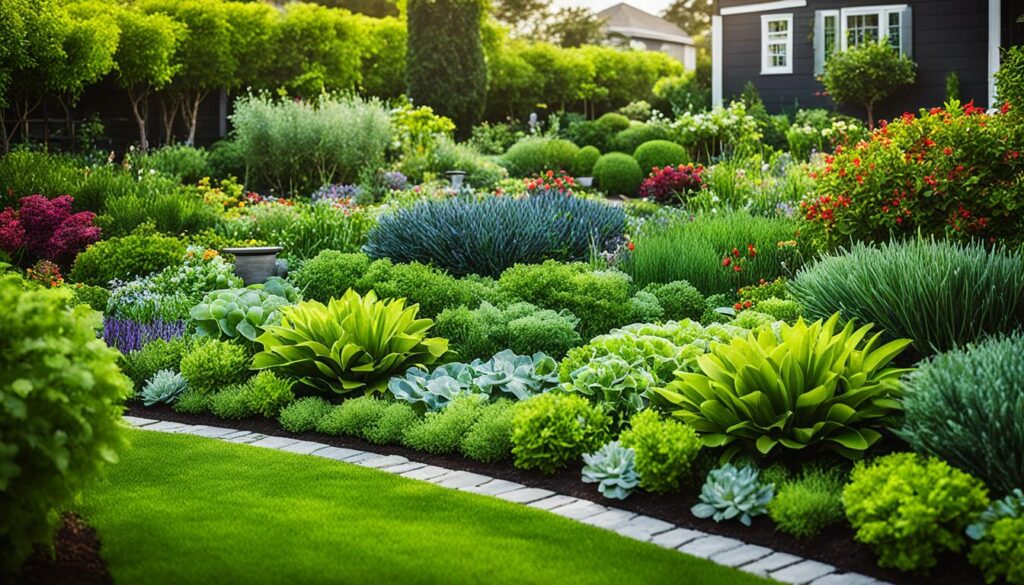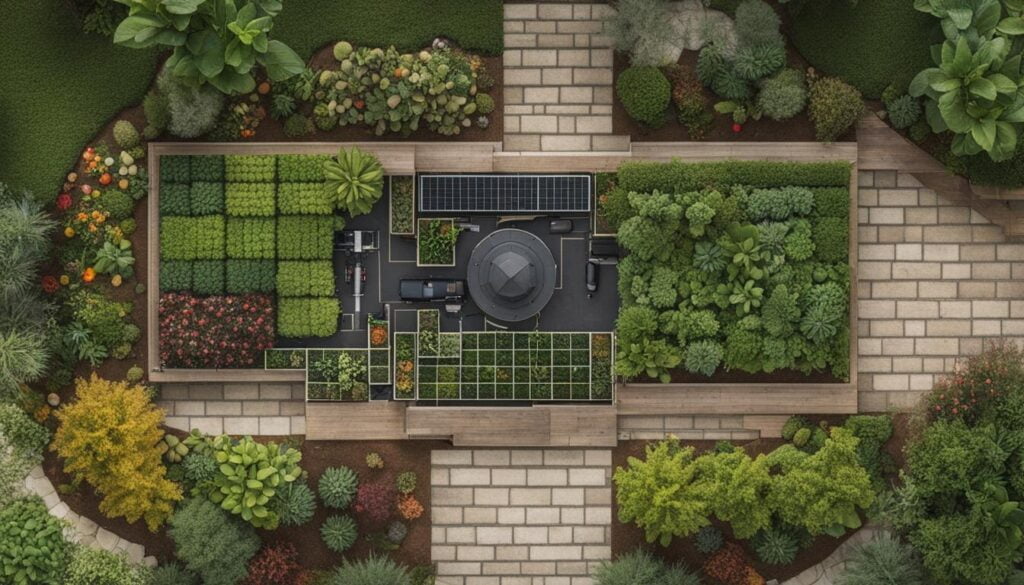Home gardens have been a staple in American culture for centuries, providing fresh produce and enhancing the beauty of homes. However, traditional gardening methods can be time-consuming and labor-intensive. Smart gardening technologies have emerged as a solution to simplify the process of growing plants. These technologies, such as sensors, automation, and the Internet of Things (IoT), enable homeowners and gardeners to automate tasks like watering, fertilizing, and lawn maintenance. The global market for smart gardening products is expected to grow rapidly, driven by the increasing popularity of home gardening and the acceptance of automation technologies.
Key Takeaways:
- Garden automation systems utilize smart gardening technologies to simplify gardening tasks.
- The use of sensors, automation, and the Internet of Things (IoT) enables tasks like watering and fertilizing to be automated.
- Smart gardening products are growing in popularity, providing convenience and efficiency for homeowners and gardeners.
- Smart gardening technologies contribute to the overall growth of sustainable gardening practices.
- The market for smart gardening products is expected to expand rapidly in the coming years.
The Benefits of Smart Gardening
Smart gardening offers various benefits for gardeners and the environment. By implementing sustainable urban gardening practices, such as space-efficient vertical gardening and urban permaculture techniques, homeowners can maximize their garden’s potential in limited spaces. Eco-friendly landscape design focuses on using native plants, conserving water, and minimizing the use of chemical inputs. Innovative water conservation techniques, such as smart irrigation systems and soil moisture sensors, help reduce water waste and promote efficient water usage. Integrating renewable energy sources into eco-gardens, such as solar panels and wind turbines, further enhances sustainability efforts. Creating wildlife habitat gardens supports biodiversity by providing food, shelter, and nesting spaces for birds, bees, and other beneficial creatures.
| Benefits of Smart Gardening | Description |
|---|---|
| Sustainable Urban Gardening | Maximizes garden potential in limited spaces through vertical gardening and permaculture techniques |
| Eco-friendly Landscape Design | Uses native plants, conserves water, and minimizes chemical inputs |
| Innovative Water Conservation Techniques | Reduces water waste and promotes efficient water usage through smart irrigation systems and soil moisture sensors |
| Renewable Energy in Eco-gardens | Enhances sustainability efforts by integrating solar panels and wind turbines |
| Wildlife Habitat Garden Creation | Supports biodiversity by providing food, shelter, and nesting spaces for birds, bees, and other beneficial creatures |
Sustainable urban gardening practices are ideal for homeowners with limited garden space. By utilizing techniques like vertical gardening and permaculture, individuals can maximize the potential of their gardens without relying on large areas of land. Vertical gardening involves growing plants in upward structures, such as walls, trellises, or stacked containers, allowing for more plants in a smaller area. Permaculture emphasizes designing gardens that are self-sustaining and mimic natural ecosystems, reducing the need for external inputs like pesticides or fertilizers.
Eco-friendly landscape design focuses on creating gardens that harmonize with the surrounding environment. By using native plants, which are adapted to local conditions, gardeners can reduce water usage and reduce the need for chemical inputs. Native plants require less maintenance and are more resistant to pests and diseases, promoting a healthier and more resilient garden ecosystem.
Innovative water conservation techniques play a crucial role in sustainable gardening practices. Smart irrigation systems and soil moisture sensors can automate watering cycles based on real-time data, ensuring that plants receive the appropriate amount of water while minimizing water waste. These technologies also prevent overwatering, which can lead to plant diseases and root rot.
Integrating renewable energy sources into eco-gardens promotes environmentally friendly practices and reduces reliance on fossil fuels. Solar panels and wind turbines can power garden lighting, irrigation systems, and other garden features, reducing electricity consumption and carbon emissions. By harnessing renewable energy, eco-gardens contribute to a greener and more sustainable future.
Creating wildlife habitat gardens is a valuable way to support biodiversity and provide habitats for various species. By incorporating native plants, bird feeders, and water sources, gardeners can attract birds, butterflies, bees, and other wildlife to their gardens. These creatures play essential roles in pollination and pest control, contributing to the overall health and productivity of the garden ecosystem.
Types of Smart Gardens
There are several types of smart gardens available on the market, each designed for specific needs and spaces. Whether you have limited indoor space or a large commercial setting, there is a smart garden option for you.
1. Indoor Hydroponic Systems
Indoor hydroponic systems utilize LED lighting and hydroponic growing methods to enable year-round plant cultivation without direct sunlight. These systems provide optimal conditions for plant growth, including precise control over nutrient levels, pH, and light cycles. With indoor hydroponic systems, you can grow a variety of plants, from herbs and leafy greens to flowers and vegetables. These innovative systems are perfect for urban dwellers or anyone who wants fresh produce right at their fingertips.
2. Portable Smart Gardens
For those who value flexibility and mobility, portable smart gardens are a great option. These compact, self-contained systems can be easily moved to different locations based on your needs or preferences. Whether you want to bring your garden indoors during the winter months or rearrange your outdoor space, portable smart gardens offer convenience and versatility. They are equipped with all the necessary components for plant growth, including automated watering, lighting, and nutrient delivery systems.
3. Smart Vertical Gardens
If you’re short on space but still want a visually appealing garden, smart vertical gardens are the perfect solution. These gardens use vertically-oriented planters that allow you to maximize your growing area by utilizing vertical space. They are designed to be space-efficient and provide an aesthetically pleasing display of plants. Smart vertical gardens often incorporate advanced irrigation systems and LED lighting to ensure optimal plant growth. Whether you have a small balcony or a tiny courtyard, smart vertical gardens can transform any space into a lush green oasis.
4. Smart Window Gardens
Smart window gardens are specifically designed for those who want to bring the beauty of nature indoors. These small systems are placed on windowsills and utilize hydroponics and LED lighting to enable plant growth in limited sunlight conditions. With smart window gardens, you can enjoy fresh herbs or vibrant flowers in any room of your house. These compact systems are easy to set up and maintain, making them ideal for beginners or those with limited gardening experience.
5. Smart Greenhouses
For larger-scale gardening or commercial settings, smart greenhouses offer advanced growing methods and automation features. These automated gardening systems provide climate control, automatic watering and fertilizing, and precise monitoring of environmental conditions. Smart greenhouses are equipped with sensors and actuators that adjust temperature, humidity, and lighting to ensure optimal plant growth. They are commonly used for commercial crop production or by gardening enthusiasts who want to take their hobby to the next level.
| Types of Smart Gardens | Description |
|---|---|
| Indoor Hydroponic Systems | Utilizes LED lighting and hydroponic growing methods for year-round plant cultivation without direct sunlight. |
| Portable Smart Gardens | Compact, self-contained systems that can be easily moved to different locations based on need or preference. |
| Smart Vertical Gardens | Uses vertically-oriented planters to save space and create a visually appealing garden. |
| Smart Window Gardens | Small systems placed on windowsills, utilizing hydroponics and LED lighting for indoor plant growth. |
| Smart Greenhouses | Automated gardening systems suitable for commercial settings, offering advanced growing methods, climate control, and automatic watering. |
Elements of a Smart Garden
A smart garden is a sophisticated system consisting of multiple layers that work in harmony to automate and optimize various gardening tasks. Each layer plays a vital role in creating a seamless and efficient gardening experience. Let’s explore the key elements of a smart garden:
1. Physical Layer
The physical layer of a smart garden encompasses the hardware components that are installed at the plant level to collect essential data. This layer includes sensors, microcontrollers, and actuators, which monitor and interact with the plants and their environment. Sensors gather data such as temperature, humidity, soil moisture, and light levels, while microcontrollers process and transmit this data to the network layer.
2. Network Layer
The network layer utilizes advanced internet and communication technologies to facilitate the seamless transmission of data from the physical layer to other connected devices or the cloud. This layer ensures that the collected data is securely and efficiently transferred, enabling remote monitoring and control of the smart garden. It allows gardeners to access real-time information and make informed decisions based on accurate data from their garden.
3. Middleware Layer
The middleware layer acts as the bridge between the hardware components and the software applications in a smart garden system. This layer is responsible for device management, context awareness, and security functions. It ensures that all the components of the smart garden ecosystem work together harmoniously, enabling smooth communication and seamless integration.
4. Service Layer
The service layer provides cloud-based solutions and services that enhance the functionality of a smart garden. It offers a wide range of features and capabilities, including sensing, actuating, and disease identification functions. With the help of the service layer, gardeners can remotely monitor and control their gardens, receive personalized recommendations, and access valuable insights to optimize their gardening practices.
5. Analytics Layer
The analytics layer leverages data analysis techniques to extract meaningful information from the vast amount of data collected by the smart garden system. It enables predictive analytics to forecast climatic changes, analyze crop yield, and detect crop diseases at an early stage. By harnessing the power of data, gardeners can make data-driven decisions and take proactive measures to ensure the health and productivity of their plants.
6. User Experience Layer
The user experience layer focuses on providing post-yield services and resources for gardeners. It includes features such as cold storage management, connecting with local farmers or gardening communities, and accessing gardening tips and resources. This layer aims to enhance the overall user experience and provide gardeners with valuable resources to support their gardening journey.
By integrating these layers, a smart garden creates a robust ecosystem that optimizes gardening tasks, improves plant health, and simplifies the overall gardening experience.
| Layer | Description |
|---|---|
| Physical Layer | Hardware components such as sensors, microcontrollers, and actuators installed at the plant level to collect data. |
| Network Layer | Internet and communication technologies that transmit data from the physical layer to the cloud or connected devices. |
| Middleware Layer | Handles device management, context awareness, and security functions in the smart garden system. |
| Service Layer | Provides cloud-based solutions for smart gardening, including sensing, actuating, and disease identification functions. |
| Analytics Layer | Uses data analysis to predict climatic changes, analyze crop yield, and detect crop diseases. |
| User Experience Layer | Focuses on post-yield services and resources such as cold storage and connecting with farmers. |
Building a Smart Garden
Building a smart garden requires careful planning and selecting the right tools and components. Start by creating a garden blueprint, considering factors such as available area, number of plants, water routes, and power sources. A well-designed garden blueprint will provide a solid foundation for your smart garden project.
When it comes to sensors, there are commercially available sensor packages designed specifically for smart gardens. These packages typically include sensors for monitoring temperature, soil moisture, humidity, pH, and brightness. These sensors play a crucial role in gathering data about your garden’s environment, allowing you to make informed decisions about irrigation, lighting, and other factors that affect plant health. Alternatively, you can choose standalone sensors based on your specific requirements and customize your sensor selection.
Another important aspect of building a smart garden is selecting the right hardware platforms. Microprocessors or microcontrollers act as the brain of your smart garden, processing data from the sensors and controlling various garden automation functions. When choosing a hardware platform, consider factors such as compatibility with your selected sensors, processing power, and connectivity options.
To ensure a successful smart garden project, it is recommended to seek expert help for specific aspects of your garden based on your unique needs. Experts can provide valuable insights and guidance on sensor placement, hardware compatibility, and overall system integration.
Sample Garden Blueprint
Here is an example of a garden blueprint:
| Area | Number of Plants | Water Routes | Power Sources |
|---|---|---|---|
| 20 ft x 10 ft | 15 | Underground irrigation pipes | Solar power |
The Importance of Using the Right Gardening Tools
Using the right gardening tools is crucial for the success of any garden. By investing in essential tools, such as a smart irrigation system, weather station, soil moisture sensor, and plant sensors, gardeners can optimize plant care and improve overall garden health. These tools enable precise monitoring of environmental conditions, allowing for accurate watering and fertilizing routines. Garden management apps provide additional convenience with features like plant identification, customized advice, and reminders for various gardening tasks. Using the right tools saves time, increases yields, offers versatility, saves money in the long run, and reduces strain and injuries.
Gardening is a delightful hobby filled with joy and satisfaction. However, to maintain a thriving garden, it’s essential to have the right tools by your side. Let’s take a closer look at some of the essential gardening tools and how they can significantly improve your gardening experience:
Smart Irrigation System
A smart irrigation system is a game-changer when it comes to watering your garden efficiently. These systems use advanced technology to analyze real-time weather data and adjust the watering schedule accordingly. By delivering the right amount of water at the right time, you can prevent over or under-watering, saving water and promoting healthier plant growth.
Weather Station
A weather station is a valuable tool that provides accurate and up-to-date weather information specific to your garden’s location. By monitoring temperature, humidity, and other climate factors, you can make informed decisions about planting, fertilizing, and protecting your plants from extreme weather conditions.
Soil Moisture Sensor
A soil moisture sensor is a must-have tool for every gardener. It measures the moisture level in the soil, allowing you to determine when to water your plants. By avoiding over-watering or under-watering, you can prevent root rot, diseases, and water wastage, providing optimal conditions for your plants’ growth.
Plant Sensors
Plant sensors are designed to monitor various aspects of plant health, including light intensity, temperature, and nutrient levels. These sensors provide valuable insights into the specific needs of your plants, helping you adjust their care accordingly. With real-time data at your fingertips, you can ensure that your plants are thriving in their ideal environment.
Garden Management Apps
Garden management apps are the digital assistants that every gardener needs. These apps offer a wide range of features, from plant identification and personalized advice to task reminders and garden planning tools. With a garden management app, you can stay organized, access expert tips, and track your garden’s progress, making your gardening journey more enjoyable and successful.
By utilizing these essential gardening tools and incorporating them into your gardening routine, you can take your garden to the next level. Whether you’re a seasoned gardener or just starting, investing in the right tools will save you time, improve the health and productivity of your plants, and ultimately enhance your gardening experience.
Conclusion
Garden automation systems, also known as smart gardening technologies, are revolutionizing how we care for our gardens. By embracing sustainable gardening practices, utilizing innovative technologies, and selecting the right tools, homeowners can greatly enhance their garden productivity while conserving valuable resources and promoting environmental sustainability.
Smart gardening offers solutions for all types of garden spaces. Whether through indoor hydroponic systems, portable smart gardens, or smart window gardens, these automated systems provide efficient and effective ways to grow plants in any setting.
By understanding the elements of a smart garden and following a step-by-step process to build or convert a traditional garden, gardeners can simplify garden care and achieve thriving green spaces. With the right tools and technologies, such as smart irrigation systems, soil moisture sensors, and plant monitoring devices, gardeners can optimize plant health and ensure their gardens flourish.
Embracing smart gardening not only enhances garden productivity but also significantly contributes to improved environmental sustainability. By conserving water, minimizing chemical inputs, and promoting biodiversity through wildlife habitat gardens, smart gardening practices allow us to create beautiful, sustainable, and eco-friendly garden spaces.
Frequently Asked Questions
What are garden automation systems?
Garden automation systems, also known as smart gardening technologies, are technologies that automate and simplify gardening tasks by utilizing sensors, automation, and the Internet of Things (IoT). These systems enable tasks such as watering, fertilizing, and lawn maintenance to be automated for convenience and efficiency.
What are the benefits of smart gardening?
Smart gardening offers various benefits including sustainable urban gardening practices, eco-friendly landscape design, innovative water conservation techniques, the integration of renewable energy sources, and the creation of wildlife habitat gardens.
What are the different types of smart gardens available?
There are several types of smart gardens available, including indoor hydroponic systems, portable smart gardens, smart vertical gardens, smart window gardens, and smart greenhouses. Each type is designed for different needs and spaces.
What are the elements of a smart garden?
A smart garden consists of different layers including the physical layer, network layer, middleware layer, service layer, analytics layer, and user experience layer. These layers work together to automate and optimize gardening tasks.
How do I build a smart garden?
To build a smart garden, start by creating a garden blueprint and considering factors such as available area, number of plants, water routes, and power sources. You can then select sensor packages or standalone sensors, choose suitable hardware platforms, and seek expert help for specific aspects of your garden.
Why is it important to use the right gardening tools?
Using the right gardening tools, such as a smart irrigation system, weather station, soil moisture sensor, plant sensors, and garden management apps, is crucial for the success of any garden. These tools optimize plant care, improve garden health, save time and money, and reduce strain and injuries.
What are the key takeaways of garden automation systems?
Garden automation systems, or smart gardening technologies, simplify garden care and offer sustainable gardening practices. By embracing these technologies, homeowners can enhance garden productivity, conserve resources, and promote environmental sustainability.











